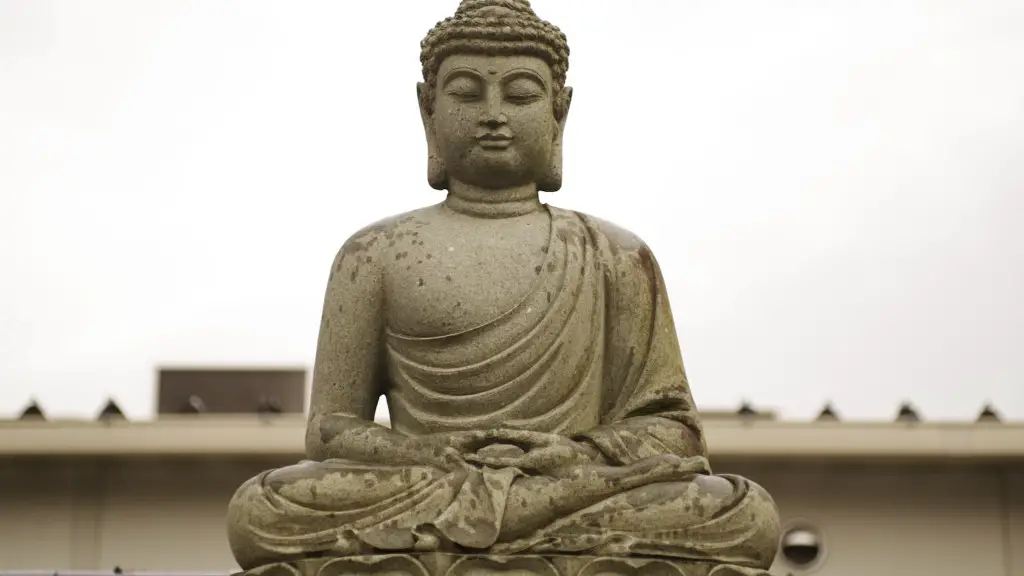Buddhism is a religion and philosophy founded in the 5th century BCE by Siddhartha Gautama. The key teachings of Buddhism include the Four Noble Truths, the Noble Eightfold Path, and the concept of Dharma. The Four Noble Truths state that suffering is universal and caused by attachment to things that are impermanent. The Noble Eightfold Path is a practical guide to help individuals end their suffering and attain enlightenment. Dharma is the cosmological and ethical principle that governs the Universe.
The key teachings of Buddhism are the Four Noble Truths and the Eightfold Path. The Four Noble Truths are the truth of suffering, the truth of the cause of suffering, the truth of the end of suffering, and the truth of the path to the end of suffering. The Eightfold Path is the path to the end of suffering, which includes right view, right resolve, right speech, right conduct, right livelihood, right effort, right mindfulness, and right concentration.
What are the 5 main teachings of Buddhism?
The Five Precepts are basic guidelines for living a moral and ethical life. They are:
1. Refrain from taking life
2. Refrain from taking what is not given
3. Refrain from the misuse of the senses
4. Refrain from wrong speech
5. Refrain from intoxicants that cloud the mind.
The Three Universal Truths are as follows:
1. All things are impermanent.
2. All things are unsatisfactory.
3. All things are empty and devoid of self-nature.
The Four Noble Truths are as follows:
1. Suffering exists.
2. Suffering has a cause.
3. There is an end to suffering.
4. There is a path to the end of suffering.
The Noble Eightfold Path is as follows:
1. Right understanding.
2. Right thought.
3. Right speech.
4. Right action.
5. Right livelihood.
6. Right effort.
7. Right mindfulness.
8. Right concentration.
What are the 10 main teachings of Buddhism
1. Life is Suffering: This is the first teaching of Buddha and it is also known as the Four Noble Truths. This truth states that life is full of suffering, pain, and grief. This is due to our attachments to things that are impermanent.
2. The Cause of Suffering: The second teaching of Buddha is that the cause of our suffering is our attachment to things that are impermanent. This attachment causes us to suffer because we are constantly chasing after things that we can never truly have.
3. The End of Suffering: The third teaching of Buddha is that there is an end to our suffering. This can be achieved by cutting off our attachments to things that are impermanent. When we do this, we will be able to find true peace and happiness.
4. The Path to the End of Suffering: The fourth teaching of Buddha is that there is a path that leads to the end of our suffering. This path is known as the Eightfold Path. It is a path that includes things like right understanding, right thought, right speech, right action, right livelihood, right effort, right mindfulness, and right concentration.
5. The Three Universal Truths: The fifth teaching of Buddha
Buddhism is a religion based on the teachings of Siddhartha Gautama, who was born in India in the 6th century BCE. The main principles of Buddhism are karma, rebirth, and impermanence. Buddhism teaches that we are all reincarnated into different forms after we die, and that our actions in this life determine our fate in the next. Buddhism also emphasizes the importance of mindfulness, or being present in the moment, as a way to achieve enlightenment.
What are the 7 rules of Buddhism?
1. Clear Viewpoint: Don’t just believe anything just because you saw it or you heard it. Be mindful and think critically about what will make you happy.
2. Values: We end up digging a hole so deep that it is hard for us to find a way back home. What is important to you? What do you value?
3. Words that Inspire: Actions in Positive Direction. Be mindful of the words you use and how they will impact your actions.
4. Efforts with Impact: Be mindful of the effort you put into everything you do. What is the impact of your actions?
5. Be Mindful: Concentrate Right. Be mindful of your thoughts and focus on what will bring you happiness.
Buddhism is a religion that is based on the belief in karma, reincarnation, and enlightenment. The Buddha, Siddhartha Gautama, taught that there is suffering in the world because people are ignorant of the true nature of reality. Nirvana is the goal of Buddhism, which is the release from selfishness and pain. Samsara is the cycle of rebirth that keeps people trapped in a cycle of suffering. The four noble truths are the foundation of Buddhist teaching, and the eight fold path is the way to liberation from suffering.
What is the golden rule in Buddhism?
The basic idea of the Golden Rule is that we should treat other people the way we want to be treated. This means that we should think about how our actions will affect other people and try to do things that will make them happy and avoid things that will make them unhappy.
The Golden Rule is found in many religions and ethical traditions and it is a good way to think about how we should treat other people. However, it is not always easy to know how other people want to be treated. Sometimes we need to ask them what they want or watch how they react to see what makes them happy or unhappy.
It is important to abstain from taking life because it is morally wrong to terminate the life of anything living. Furthermore, it causes suffering not only to the victim, but also to the perpetrator. Additionally, taking life goes against the laws of nature and the natural order of things.
What is the main goal of Buddhist philosophy
Nirvana is the goal of Buddhism and is believed to be attainable only with the elimination of all greed, hatred, and ignorance within a person. Nirvana signifies the end of the cycle of death and rebirth.
Buddhism is one of the largest religions in the world. It has 360 million followers. It does not have a single holy book. Its scriptures are preserved in many Asian languages. It does not believe in a supreme being or creator god.
What are the four rules of Buddhism?
The Four Noble Truths comprise the essence of Buddha’s teachings. They are the truth of suffering, the truth of the cause of suffering, the truth of the end of suffering, and the truth of the path that leads to the end of suffering. These truths leave much left unexplained, but they provide a framework for understanding the Buddha’s teachings.
The Dharmachakra is one of the most important symbols of Buddhism. It is a wheel that is turned when the Buddha is teaching. The wheel represents the Buddha’s teachings.
What religion believes in karma
Karma is often understood as a form of cosmic justice, where good deeds are rewarded and bad deeds lead to suffering. In some traditions, karma is seen as a force that determines the future of a person, often in terms of their next life.
The concept of karma is often used to explain the cycle of birth and death, as well as to justify inequalities in the world. Some believe that a person’s karma is responsible for their station in life, and that it is impossible to escape one’s karma.
Others view karma as a more personal force, something that is within each individual’s power to change. This more positive view of karma emphasizes the potential for transformation and growth, even in the face of difficult circumstances.
Śīla in Buddhism is a code of conduct that is based on the principle of nonviolence and self-restraint. The main motivation for following Śīla is to cause no harm. Śīla is one of three sections of the Noble Eightfold Path, and adhering to it leads to a life of harmony.
What is Buddhism vs Christianity?
There are many differences between Buddhism and Christianity, but one of the most significant is that Christianity is based on monotheism, while Buddhism generally does not believe in a supreme creator god. This means that Christians believe in one god who created and controls the universe, while Buddhists typically believe that everything is interconnected and interdependent. This can lead to different values and perspectives on the world.
When you are in a temple or around Buddhist holy sites, it is important to be respectful. Keep your hands down and to your side, and don’t point at anything. It is also considered disrespectful to touch or climb on a Buddha statue. If a monk or nun enters the area, stand up out of respect. Lastly, try not to be higher than a monk – for example, don’t stand next to a sitting monk.
Conclusion
Buddhism aims to provide a path of spiritual development that leads to nirvana—the extinction of greed, hatred, and ignorance—and hence to freedom from the cycle of birth and rebirth. The key teachings of Buddhism can be summarised as follows:
The Four Noble Truths: that suffering is an inherent part of life; that the origin of suffering is desire; that suffering can be ended; and that the path to the end of suffering is the Noble Eightfold Path.
The Noble Eightfold Path: right understanding, right thought, right speech, right action, right livelihood, right effort, right mindfulness, and right concentration.
The Three Universal Truths: that everything is impermanent, that everything is suffering, and that there is no Permanent Self or soul.
The Law of karma: that good actions lead to happiness and bad actions lead to suffering, and that the quality of an action depends on the intention behind it.
Rebirth: that the actions of an individual in one lifetime determine the conditions of their life in future lifetimes, and that it is possible to end the cycle of rebirth by attaining nirvana.
Buddha-nature: that every individual has the potential to attain
There are numerous key teachings of Buddhism, however, the most fundamental teaching is the Four Noble Truths. The Four Noble Truths are: (1) the truth of suffering, (2) the truth of the origin of suffering, (3) the truth of the cessation of suffering, and (4) the truth of the path leading to the cessation of suffering. Other key teachings of Buddhism include the Eightfold Path, the Three Universal Truths, and the Five Precepts.



